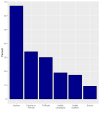Awareness of Acute Stroke Among the General Population in the Western Region of Saudi Arabia
- PMID: 38344539
- PMCID: PMC10853589
- DOI: 10.7759/cureus.51979
Awareness of Acute Stroke Among the General Population in the Western Region of Saudi Arabia
Abstract
Background A stroke is an abrupt neurological deficit that occurs due to a vascular origin. Stroke is one of the main causes of functional disability and irreversible brain damage globally. Following cancer and ischemic heart disease, stroke ranks as the third-highest contributor to adult mortality. According to studies conducted in Saudi Arabia, the estimated annual incidence of stroke was 29.8 per 100,000 individuals. Patients who are at risk for stroke and their families should be aware of the danger of stroke and be familiar with the symptoms. Stroke warning signs include abrupt weakness in the face or limbs, confusion, speech slurring, vision problems, difficulty in walking, and severe headache with no obvious explanation. The burden of stroke consequences can be greatly reduced by early detection of stroke symptoms and prompt treatment for acute attacks. A delay in seeking medical attention following a stroke attack has been linked to poor knowledge of stroke symptoms and risk factors. Furthermore, an important factor in reducing the incidence of stroke is public awareness of risk factors, symptoms, and prevention strategies. General awareness of stroke leads to a proper response to stroke, pursuit of medical treatment, and a better outcome. Aim The aim of this study is to assess the awareness of acute stroke among the general population in the Western Region of Saudi Arabia. Methodology A cross-sectional study was conducted in 2023 in the western region of Saudi Arabia. An online, validated, self-administered questionnaire was distributed randomly. The estimated sample size was 385, and 539 were the collected responses. Results More than half of the respondents were females (66.0%) (n=356), aged 20 to 29 years (50.3%) (n=271). In general, the majority of respondents had correctly identified that the elderly are at high risk for stroke (92.8%) (n=500) and that stroke can cause death (81.6%) (n=440). More than half of the population under study (59.9%) (n=323) correctly indicated that stroke is preventable. However, only (11.3%) (n=61) of them stated that the ideal timeframe to initiate thrombolysis in acute cases is 4.5 hours. Regarding the risk factors of stroke, the most frequently identified factors included hypertension (84.4%) (n=455) and heart disease (64.6%) (n=347). When the participants were asked about the warning signs and symptoms of stroke, the most commonly identified response was confusion (70.3%) (n=379). A good knowledge level was prevalent among 311 participants (57.7%, 95% CI, 53.4 to 61.9). Good knowledge levels were significantly higher among participants aged 20 to 29 years (63.5%) (n=172) and 60 years or more (65.2%) (n=15) compared to other categories. A significantly higher proportion of non-Saudis had higher knowledge levels ((75.9%) (n=22) versus (56.7%) (n=289), p = 0.042). Results of the multivariate analysis showed that participants aged 40 to 49 years (OR = 0.54, 95% CI, 0.33-0.89; p = 0.016) and 50 to 59 years (OR = 0.37, 95% CI, 0.21 to 0.63, p < 0.001) were less likely to have good knowledge levels. Conclusion The findings of this study indicate that (57%) (n=307) of participants had adequate knowledge of acute stroke. However, public education programs are still required to further expand this knowledge.
Keywords: acute stroke; awareness; awareness of acute stroke; cross sectional studies; stroke awareness; stroke knowledge; stroke prevention; stroke risk factors; stroke symptoms.
Copyright © 2024, Hawati et al.
Conflict of interest statement
The authors have declared that no competing interests exist.
Figures
Similar articles
-
Awareness of Stroke Risk Factors and Warning Signs Among Diabetic Patients in the Aseer Region, Saudi Arabia: A Cross-Sectional Study.Cureus. 2023 Jul 27;15(7):e42562. doi: 10.7759/cureus.42562. eCollection 2023 Jul. Cureus. 2023. PMID: 37637536 Free PMC article.
-
Stroke Knowledge and Response Among the General Population in Saudi Arabia: A Population-Based Survey.Cureus. 2024 Jul 28;16(7):e65587. doi: 10.7759/cureus.65587. eCollection 2024 Jul. Cureus. 2024. PMID: 39192923 Free PMC article.
-
Public Awareness and Attitude Towards Stroke in the Southern Region of Saudi Arabia: A Cross-Sectional Study.Cureus. 2025 Apr 8;17(4):e81910. doi: 10.7759/cureus.81910. eCollection 2025 Apr. Cureus. 2025. PMID: 40342482 Free PMC article.
-
Global Awareness and Response to Early Symptoms of Acute Stroke: A Systematic Literature Review.Cureus. 2025 Feb 3;17(2):e78420. doi: 10.7759/cureus.78420. eCollection 2025 Feb. Cureus. 2025. PMID: 39916816 Free PMC article. Review.
-
Primordial and Primary Prevention of Ischemic Stroke in Saudi Arabia: A Combination Approach and Evolving Concepts.Saudi J Med Med Sci. 2024 Jan-Mar;12(1):1-9. doi: 10.4103/sjmms.sjmms_62_23. Epub 2024 Jan 15. Saudi J Med Med Sci. 2024. PMID: 38362089 Free PMC article. Review.
Cited by
-
Glial Cell Reprogramming in Ischemic Stroke: A Review of Recent Advancements and Translational Challenges.Transl Stroke Res. 2025 Oct;16(5):1811-1835. doi: 10.1007/s12975-025-01331-7. Epub 2025 Feb 4. Transl Stroke Res. 2025. PMID: 39904845 Review.
-
The Effects of Functional Electrical Stimulation of Hip Abductor and Tibialis Anterior Muscles on Standing and Gait Characteristics in Patients with Stroke.J Clin Med. 2025 Mar 28;14(7):2309. doi: 10.3390/jcm14072309. J Clin Med. 2025. PMID: 40217759 Free PMC article.
References
-
- Stroke in KSA: epidemiology and clinical delineation. Muhammad A, Aljohani M. Majmaah J Health Sci. 2021;9:109–120.
-
- Public awareness of stroke among adult people in Eastern Region of Saudi Arabia, community-based cross-sectional study. Mousa O, Almujhem AA, AlJumaan RO, AlOthman MA, Sayed A. Merit Res J Med Med Sci. 2020;8:319–326.
-
- Risk factors for ischemic stroke: differences between cerebral small vessel and large artery atherosclerosis aetiologies. Shi Y, Guo L, Chen Y, et al. Folia Neuropathol. 2021;59:378–385. - PubMed
-
- Primary and secondary prevention of ischemic stroke and cerebral hemorrhage. Diener HC, Hankey GJ. J Am Coll Cardiol. 2020;75:1804–1818. - PubMed
LinkOut - more resources
Full Text Sources



